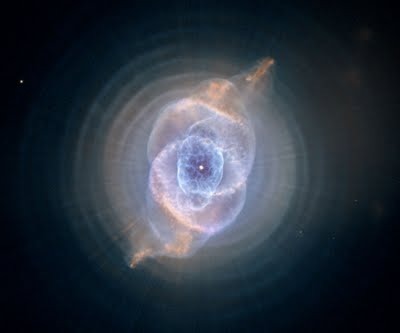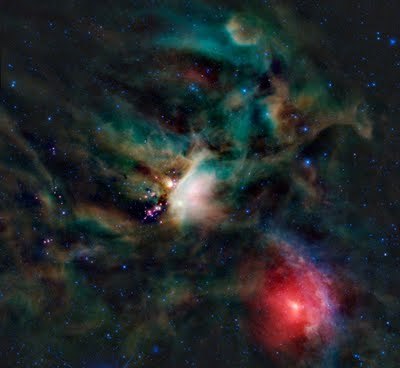Eleanor Arnason's Blog, page 76
June 30, 2011
NASA APOD

Sculpted by stellar winds and radiation, the star factory known as Messier 17 lies some 5,500 light-years away in the nebula-rich constellation Sagittarius. At that distance, this degree wide field of view spans almost 100 light-years, courtesy of the European Southern Observatory's new VLT Survey Telescope and OmegaCAM. The sharp, false color image includes both optical and infrared data, following faint details of the region's gas and dust clouds against a backdrop of central Milky Way stars. Stellar winds and energetic light from hot, massive stars formed from M17's stock of cosmic gas and dust have slowly carved away at the remaining interstellar material producing the cavernous appearance and undulating shapes. M17 is also known as the Omega Nebula or the Swan Nebula.
Published on June 30, 2011 09:11
May 11, 2011
Joanna Russ
Joanna Russ has died after several strokes. She was formidable person in the science fiction community, especially to women of my generation, an impressive writer of fiction and an impressive feminist critic. I found it difficult to read her fiction, since much of it seemed angry to me, and I have trouble with anger. Open anger -- expressed anger -- has always made me uncomfortable. At the same time, I feel I am too often angry, mostly at this society, which is both greedy and stupid. I don't think anger is useful, unless it leads to action. Even then, angry action can backfire. It's better to remain calm and act, if that's possible.
The person I would most like to emulate is Howard Zinn, a good-humored man whose life was full of action. The world didn't make him angry. It made him act to change the world. He was in the civil rights movement and the peace movement and wrote The People's History of the United States, among many other books and essays. Zinn kept going till he died in his 80s, while swimming laps in a pool.
Anyway, I have difficulty with Russ.
She was troubled with chronic back pain and chronic fatigue syndrome; and in her later years she didn't write much -- no fiction, as far as I know, and little criticism. It's hard to judge another person's pain or fatigue. Did her health make it impossible for her to write? Or had her passion burned her out?
In her case, she had acted enough through her writing and criticism. She didn't need to do more. Someone who knew her said she got the impression that Russ had lost interest in science fiction, had moved on and was enjoying her new life. She retired to Arizona, a better climate for her health, and took up watching birds.
Thinking about her life has made me want to keep writing. I feel I've picked a very small area in which to be effective: science fiction. But it's my community, and it talks about the future. It says change is possible and inevitable. The question always is, what kind of change will it be? What kind of future can we make? What kind of future are we making now?
The person I would most like to emulate is Howard Zinn, a good-humored man whose life was full of action. The world didn't make him angry. It made him act to change the world. He was in the civil rights movement and the peace movement and wrote The People's History of the United States, among many other books and essays. Zinn kept going till he died in his 80s, while swimming laps in a pool.
Anyway, I have difficulty with Russ.
She was troubled with chronic back pain and chronic fatigue syndrome; and in her later years she didn't write much -- no fiction, as far as I know, and little criticism. It's hard to judge another person's pain or fatigue. Did her health make it impossible for her to write? Or had her passion burned her out?
In her case, she had acted enough through her writing and criticism. She didn't need to do more. Someone who knew her said she got the impression that Russ had lost interest in science fiction, had moved on and was enjoying her new life. She retired to Arizona, a better climate for her health, and took up watching birds.
Thinking about her life has made me want to keep writing. I feel I've picked a very small area in which to be effective: science fiction. But it's my community, and it talks about the future. It says change is possible and inevitable. The question always is, what kind of change will it be? What kind of future can we make? What kind of future are we making now?
Published on May 11, 2011 21:00
I'm spending most of my Internet time at facebook, rather than updating my blog. I've never liked chit chat, but I certainly enjoy the brief comments on facebook -- how people are spending their day, what's for dinner, what they are reading, photos of pets and kids. I lead a specialized life. Most of the people I know in the real world are members of the science fiction community, and most of my facebook "friends" are part of the same community: writers, editors, reviewers, critics, fans. So we do discuss science fiction. But mostly it's the minutia of daily life, which is oddly appealing.
Published on May 11, 2011 20:46
April 25, 2011
Minicon
The second day at Minicon was better. I was tired. I went to panels and listened and didn't speak from the audience. I talked a bit to people I know. But I didn't feel the need to be charming and witty.
If I could learn to be this relaxed every day at cons, I would enjoy them more. I am, after all, old enough so I don't have to impress people.
If I could learn to be this relaxed every day at cons, I would enjoy them more. I am, after all, old enough so I don't have to impress people.
Published on April 25, 2011 10:10
April 24, 2011
MInicon
I was at Minicon all day yesterday. I had some good conversations with friends, but as usual I talked too much. This is a typical reaction to conventions, especially ones where I know a lot of people.
One of my fantasies is to go to a science fiction convention where I know no one. I would go to panels, a lot of them, and listen and say nothing. Sit alone in the hotel restaurant and write in my journal. Think about science fiction and fantasy and the SF community.
I would probably end up feeling lonely and neglected. But as a fantasy it seems lovely and restful.
Maybe I should try it at some con like World Fantasy. The last time I checked it, I recognized almost no one on the membership list.
One of my fantasies is to go to a science fiction convention where I know no one. I would go to panels, a lot of them, and listen and say nothing. Sit alone in the hotel restaurant and write in my journal. Think about science fiction and fantasy and the SF community.
I would probably end up feeling lonely and neglected. But as a fantasy it seems lovely and restful.
Maybe I should try it at some con like World Fantasy. The last time I checked it, I recognized almost no one on the membership list.
Published on April 24, 2011 06:31
An Awesome Image from NASA

Staring across interstellar space, the alluring Cat's Eye nebula lies three thousand light-years from Earth. A classic planetary nebula, the Cat's Eye (NGC 6543) represents a final, brief yet glorious phase in the life of a sun-like star. This nebula's dying central star may have produced the simple, outer pattern of dusty concentric shells by shrugging off outer layers in a series of regular convulsions. But the formation of the beautiful, more complex inner structures is not well understood. Seen so clearly in this sharp Hubble Space Telescope image, the truly cosmic eye is over half a light-year across. Of course, gazing into the Cat's Eye, astronomers may well be seeing the fate of our sun, destined to enter its own planetary nebula phase of evolution ... in about 5 billion years.
Published on April 24, 2011 06:30
April 19, 2011
I Can Remember
Another poem.
Most likely, it is too sentimental. But I am sentimental about Detroit.
I can remember people standing in line outside bars
at seven or eight a.m., waiting for the doors to open.
That was in Detroit when the town ran day and night,
making cars at Dodge Main, Highland,
Eldon Gear and Axle, Cadillac.
A guy got off the night shift sweating and tired,
eight hours of building America, and he wanted a beer.
That's all gone now; grass grows
where the plants stood and workers had their houses.
I could mourn Detroit the way Jeremiah
mourned Jerusalem.Who builds America now?
Where are the workers out of a poem by Sandberg:
broad-shouldered and covered with sweat,
pissed at the straw boss, ready for a beer?
Most likely, it is too sentimental. But I am sentimental about Detroit.
Published on April 19, 2011 16:07
April 14, 2011
NASA

Dust clouds and embedded newborn stars glow at infrared wavelengths in this tantalizing false-color composition from WISE, the Wide-field Infrared Survey Explorer. The cosmic canvas features one of the closest star forming regions, part of the Rho Ophiuchi cloud complex some 400 light-years distant near the southern edge of the pronounceable constellation Ophiuchus. After forming along a large cloud of cold molecular hydrogen gas, young stars heat the surrounding dust to produce the infrared glow. Stars in the process of formation, called young stellar objects or YSOs, are embedded in the compact pinkish nebulae seen here, but are otherwise hidden from the prying eyes of optical telescopes. An exploration of the region in penetrating infrared light has detected emerging and newly formed stars whose average age is estimated to be a mere 300,000 years. That's extremely young compared to the Sun's age of 5 billion years. The prominent reddish nebula at the lower right surrounding the star Sigma Scorpii is a reflection nebula produced by dust scattering starlight. This view from WISE spans almost 2 degrees and covers about 14 light-years at the estimated distance of the Rho Ophiuchi cloud.
Published on April 14, 2011 05:40
April 13, 2011
Poetry
I found the notebook I took east with me in February, and it contained three poems I never input to my computer. (I took a computer with me, Patrick's eee-pc, but the poems were scrawled in the notebook.) It's a very nice Marimekko notebook with a terrific Cross pen. Unfortuntely, I collect notebooks and pens, and both can get lost in the multitudes.
Anyway, here are the poems. They are not great, but I kind of like them:
I hasten to add, it was not my liverwurst sandwich on soft, white bread. It belonged to the guy across the aisle. He appeared to enjoy it.
I am probably being unfair to the guy with his pants falling off. People mocked what I and my friends wore when we were young. Now, I'm doing the same.
I like the thaw poems best, I think because I'm mocking myself, not other people.
Anyway, here are the poems. They are not great, but I kind of like them:
Plane Lunch
High above the white clouds --
a liverwurst sandwich
on soft, white bread.
I hasten to add, it was not my liverwurst sandwich on soft, white bread. It belonged to the guy across the aisle. He appeared to enjoy it.
Thaw Poems
I.
Temp above freezing --
great heaps of dirty snow
melt into wet streets.
II.
No longer lithe,
I cannot leap
over great heaps
of frozen snow.
Better they go.
Fashion Statement on the 94-B Bus
I'm looking at young people,
thinking how good they look,
when a guy with his pants falling off
and his red and white undershorts showing,
gets on the bus.
I am probably being unfair to the guy with his pants falling off. People mocked what I and my friends wore when we were young. Now, I'm doing the same.
I like the thaw poems best, I think because I'm mocking myself, not other people.
Published on April 13, 2011 06:56
April 12, 2011
NASA APOD

On April 12th, 1961, Soviet cosmonaut Yuri Alexseyevich Gagarin became the first human in space. His remotely controlled Vostok 1 spacecraft lofted him to an altitude of 200 miles and carried him once around planet Earth. Commenting on the first view from space he reported, "The sky is very dark; the Earth is bluish. Everything is seen very clearly". His view could have resembled this image taken in 2003 from the International Space Station. Alan Shepard, the first US astronaut, would not be launched until almost a month later and then on a comparatively short suborbital flight. Born on March 9, 1934, Gagarin was a military pilot before being chosen for the first group of cosmonauts in 1960. As a result of his historic flight he became an international hero and legend. Killed when his MIG jet crashed during a training flight in 1968, Gagarin was given a hero's funeral, his ashes interred in the Kremlin Wall. Twenty years later, on yet another April 12th, in 1981, NASA launched the first space shuttle.
Published on April 12, 2011 11:07
Eleanor Arnason's Blog
- Eleanor Arnason's profile
- 73 followers
Eleanor Arnason isn't a Goodreads Author
(yet),
but they
do have a blog,
so here are some recent posts imported from
their feed.



